Overview
1
Audience
People managers at Brightwell Dynamics who need practical support to lead engaging, trust-building one-on-one conversations.
2
Tools
-
Articulate Storyline 360
-
Adobe Illustrator
-
ChatGPT
-
Canva
-
Miro
-
Figma
-
Google Suite
3
Responsibilities
I designed and developed the project from concept to completion.
Key responsibilities included:
Instructional Design,
Action Mapping, Visual Design, and Storyboarding
The Problem
This concept project is for Brightwell Dynamics, a fast-growing tech and logistics company. Rapid expansion and recent acquisitions have led to an influx of new managers—many stepping into leadership roles for the first time.
Without consistent guidance, these managers often struggled to engage their direct reports effectively. They’re unsure how to address performance issues in a way that builds trust and accountability. As a result, employee morale is slipping, engagement is low, and turnover is on the rise.
The Solution
After analyzing the problem, I determined that a multifaceted solution would be required, starting with a scenario-based eLearning experience. There, managers would be able to practice real feedback conversations in a risk-free environment to build skills, resulting in higher employee morale and productivity.
The module uses interactive choices, a dynamic engagement meter, and realistic consequences to build awareness; Elements that gamify the learning experience.
To support lasting change, I also developed a downloadable coaching planner and recommended initial culture coaching and follow-ups from senior leadership.
My Process
Following the ADDIE model, I analyzed the problem and used an action map to clarify key decisions and performance goals. I then designed a targeted, scenario-based solution grounded in Gagné’s Nine Events and Mayer’s Multimedia Principles to support real-world application.
I created storyboards, mockups, and a functional prototype—refining each stage with feedback before final development to ensure clarity and impact.
Action Mapping
With the support of ChatGPT, I served as the subject matter expert for this project, brainstorming with the AI engine and drawing on my own background in behavior science and leadership development. I began by creating an action map centered around improving employee engagement through trust-building feedback and collaboration. Each branch reflects practical, real-world decisions that align with measurable outcomes like retention, engagement scores, and performance. This ensured that the scenario focused on relevant, high-impact behaviors that new managers need to master to drive engagement and foster a healthy team culture.

Text-Based Storyboard
Using the action map as a foundation, I created a text storyboard that follows Taylor, a disengaged team member. This scenario- based learning gives the learner opportunities to practice coaching through dialogue and decision points. Each decision point is tied to a meaningful consequence, allowing learners to test strategies in a risk-free setting with a mentor character to guide the learner and encourage reflection.
I developed all dialogue, programming notes, scenario outcomes, and mentor prompts to model clear, supportive coaching conversations.

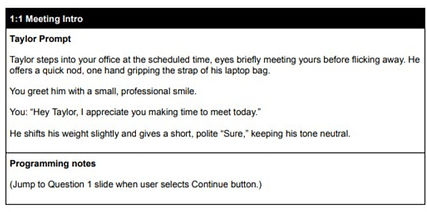

Visual Mockups
Once the storyboard was finalized, I moved into the visual design phase. I used Adobe Illustrator to customize the characters and created mockups in Figma, exploring various potential characters, elements, and layouts. The experience reflected a modern workplace and was kept free of extraneous distractions to promote focus on the learning objective. I designed a consistent layout, color palette, and interface elements that further supported learner focus. The engagement meter was styled to feel intuitive and added an aspect of gamification to the immersive learning experience.





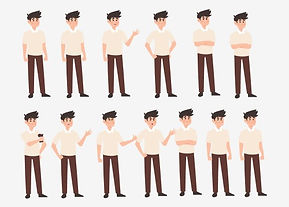



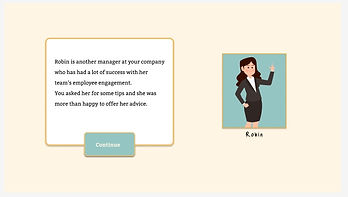


Interactive Prototype
Using my storyboard and mockups as a guide, I built an interactive prototype in Articulate Storyline 360 to test the flow and functionality of the scenario. The prototype included the introduction, decision points, mentor feedback layers, and the engagement meter to show real-time consequences and give initial users a feel for the experience. I shared this version with peers to gather evaluative feedback on flow, visual clarity, and user experience, refining the experience before moving forward into full development.

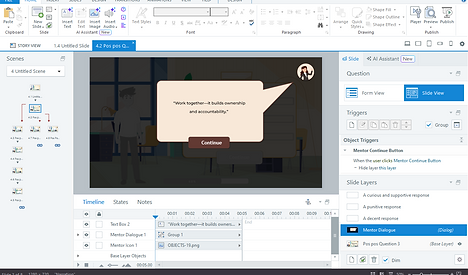
Full Development
After integrating feedback from the prototype phase, I developed the full scenario. I programmed each decision point with natural transitions, responsive feedback, and a dynamic engagement meter that reinforced the learning objectives through real-time consequences.
I used variables and conditions to trigger appropriate consequences based on learner choices and added hover states and animations draw attention to the mentor’s guidance. I also designed dedicated mentor layers with distinct visual style to set them apart from the main scenario.
Each decision point influences both the engagement score and Taylor’s demeanor. The learner can encounter one of three possible endings and must select all the best responses to successfully complete the training module. Just befor completing the training, learners have the option to download a fillable PDF designed to help plan effective one on one meetings.
Project Features:
Scenario Branching with Multiple Endings
Custom Visuals
Custom Animations
Gamification - Engagement Meter
Prescriptive Feedback - Mentor
Downloadable Planning Document

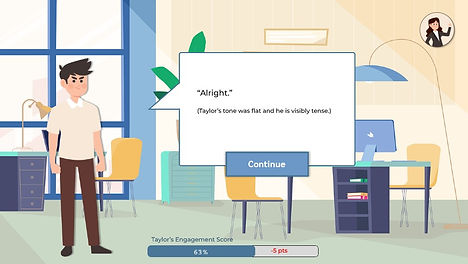

Reflections and Next Steps
Completing this project from start to finish has strengthened my instructional design, storytelling, and eLearning development skills. Each phase of this project presented new insights that I’ll apply to create even stronger learning solutions ahead.
I received great feedback from peers and mentors on the dynamic engagement meter, clean visual design, and immersive structure of the scenario. This process reinforced the value of early analysis and user experience testing. Clear goals and thoughtful planning made the development phase smoother and more effective.
With additional time and resources, there are several meaningful ways to expand and enhance this concept project.
-
Audio Elements - Adding sound effects to this experience could make it more immersive. This could be things as simple as general interface sounds when a learner clicks a button, or when the engagement meter increases or decreases. It could also be something more involved like voiceovers to help the project be more accessible to individuals with vision impairment, for example.
-
Video Elements - An initial training of best practices in leadership communication might be a great way to ensure learners are on more equal footing when they begin the scenario. This way, the project could better employ Gagne's 9 Events and stimulate recall from the training to apply to the practice situations.
-
More Complex Animations - Animations add life to the project and retain the attention of the learner, adding delight to the experience. More complex animations could be added to the project, whether that be character animations, environmental animations or interface animations.
-
Expanded Direct Report Interactions - In this project, learners met with one direct report, Taylor. If the project were expanded, it could include interactions with additional characters so learners could practice their leadership skills across personality types and performance issues.
-
Expanded Gamification Elements - Gamifying elements greatly enhance the attention retention and engagement of a learning experience like this one. It would be really fun to have quirky animations (Easter eggs) into parts of the background for learners to discover. Something like an achievement or badge system could also be implemented as well as a leaderboard.
-
AI Integration - Likely the most impactful and exciting way to evolve this project would be to incorporate AI. Adaptive learning could be implemented by integrating ChatGPT to power dynamic dialogues with both the mentor and employee characters. This would allow learners to navigate open-ended conversations with realistic, nuanced responses. To support that vision, I’m actively building coding skills that will help bring more innovative, personalized learning experiences to life.
I love this work, particularly the hands-on development phase. The most enjoyable aspect of this work is problem-solving in Storyline. I find the challenge of experimenting with different approaches deeply satisfying, and I thrive when given space to build, tinker, and refine. I’m excited to keep growing as a creative, tech-forward instructional designer.
